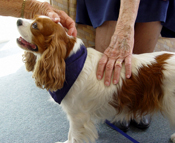|
Home History Breed Standard Barking Help Nipping & Biting Help Cavalier King Charles Spaniel Breed Standard
Thanks for joining us as we discuss the breed standard of this wonderful dog.
The Cavalier King Charles Spaniel is as well known for its attitude and behavior in the show ring as it is for its physical appearance. The dog should be happy and enthusiastic, and should have a fearless and sporting appearance while also being loving and affectionate towards people. The breed should have a fluid movement, and a natural grace as would have been required in their origins as a hunting dog in England. While there are no hard and fast guidelines for height and weight, the average Cavalier King Charles Spaniel will be twelve to thirteen inches at the shoulders, and will weigh between thirteen and eighteen pounds (5.8 - 8 kilograms). Variations on the size will be permitted if the body is in balance overall, and the dog is proportion weight and size wise. Head The head should be in balance with the rest of the dog and should not be overly large or small. The eyes should be dark brown and lustrous looking but not be protruding or sunken in appearance. The eyes themselves will be round in shape and there will be cushioning under the eyes to give a soft appearance to the expression. The ears of the Cavalier King Charles are set relatively high on the head and should be feathered. They should frame the face when the dog is attending to something and should extend well below the lower jaw line. The skull should be flat in appearance due to the location of the ears, and there should be no dome shape to the skull although it will be slightly rounded. The muzzle should be approximately 1-˝ inches from the stop to the end of the slightly tapered nose. The nose should be all black without any other coloration or pigmentation. The teeth and jaw should be square fitting with the top teeth fitting over the bottom teeth in a complete scissors bite. Body The neck of the Cavalier King Charles should be muscular and slightly crested to give a powerful and sporty look to the animal. The body should remain flat when standing and moving, and should appear to be athletic and graceful. The chest should be deep but not over developed in a barrel chest. The ribs should be wide but not extended looking, and there will be no noticeable tuck-up after the last rib. The front legs should be straight and sturdy looking with no turning in or out of the feet. Dewclaws may be removed, and the hair may be trimmed from the pads. The back legs, like the front, should be squared with each other and with the body with no turning in or out. The coat should be natural. There is no trimming, altering or shaping of the natural coat allowed in the show ring. Any modifications of the coat result in disqualification. The Cavalier King Charles Spaniel can be of the following colors: Blenheim Chestnut markings on a pearl white coat. The ears must be chestnut, and it is desirable to have the “Blenheim Spot” - or a small chestnut marking - on the white background between the ears. It is not required for show, but is favored among breeders. Tri-color Absolutely jet black markings on a white background. The black extends over the ears and around both eyes in a symmetrical and balanced pattern. A white blaze will run down the head between the eyes. Tan markings can occur over the eyes, on the sides of the cheeks, on the insides of the ears as well as underneath the tail. The markings should be balanced on both sides of the dog. Ruby The whole dog is a rich red color. Black and tan The black coat is highlighted by tan eyebrows, cheek markings and the undersides of the ears and tail. White is considered a fault on the ruby and black and tan colors. Ticking is a fault on the Blenheim and Tri-colors. Tail The tail can be docked or left natural. If the tail is docked it cannot have more than one-third of the total length removed. The tail should be set fairly high and should be carried at the height of the back but not too far above. The tail will constantly be in a sweeping motion when the dog is moving. Gait The Cavalier King Charles Spaniel should appear square at all times when moving. The gait should be energetic yet controlled, and should have a good length of stride relative to the dog’s size. The feet should not be thrown or rolled to the sides as the dog moves. Temperament The Cavalier King Charles Spaniel should be outgoing and friendly in the ring. They should not appear timid, shy or aggressive. Conclusion The standard of the Cavalier King Charles Spaniel were first developed in 1945 and were based on an actual dog by the name of Ann’s Son. These standards have remained constant since they were first implemented. I am sorry if that was all a bit "dry" but it is a little tricky to make the breed standards exciting. Thanks for visiting us and we hope you enjoyed learning a little about the breed standard of the Cavalier King Charles Spaniel. Feel free to look around some more at our other pages on our Cavalier King Charles website. For further detailed information, please consider the Insider's Complete Guide To The Cavalier King Charles Spaniel This ebook and audio package includes detailed training guidance and tips and other extensive resources to best care for your doggy. There is also a FREE online Cavalier King Charles course available from the homepage. Just Click Here for more details. Bye for now and thanks again for visiting.
|
